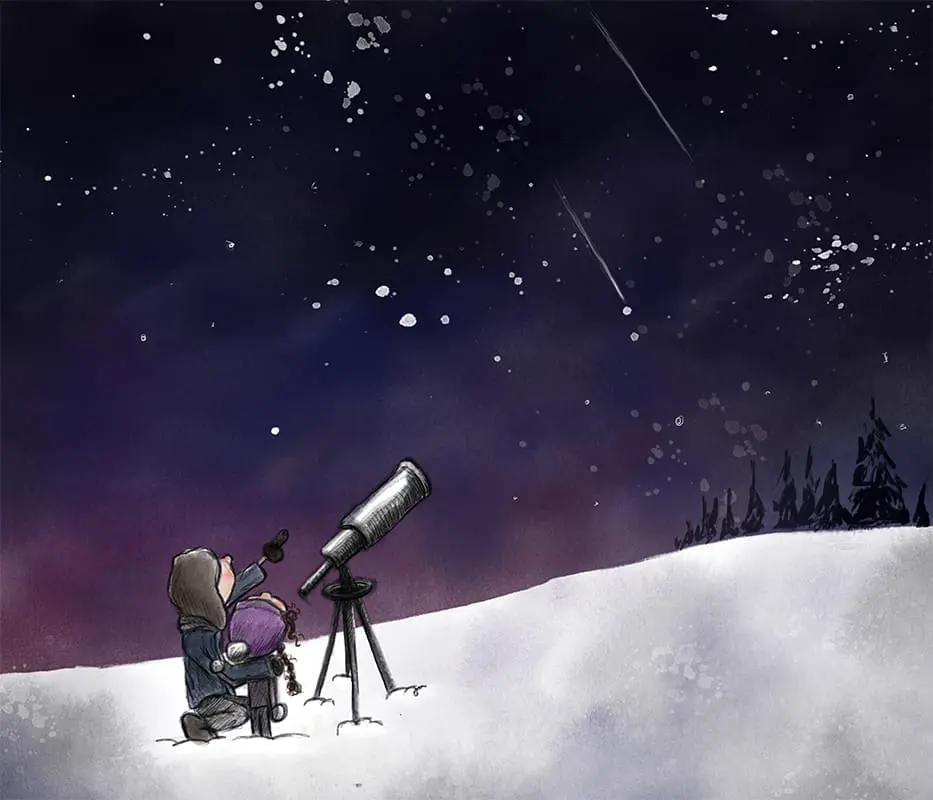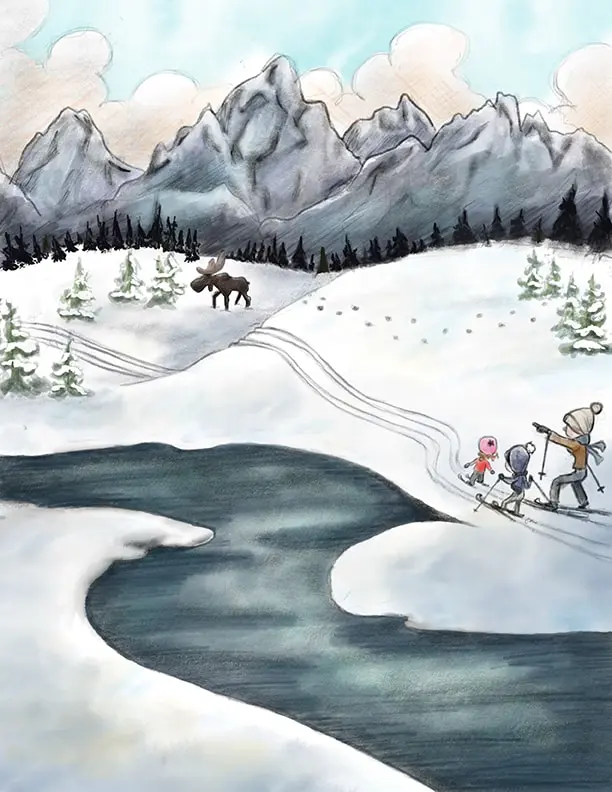By Tibby Plasse // Illustrations by Julie Millard
—
When you look outside your window, the view on either side of the Tetons is a good one. It’s become clear during this new era of pandemic restrictions that we’re really lucky to be living in a land of many uses. Yes, the recreation is unmatched, but on a deeper examination of the surrounding lands and water, something else becomes apparent—the greater Yellowstone region always has something to teach us.
Too often we quarantine (no pun intended) learning experiences to the classroom, a museum, or the park, but when you live in the mountains, the opportunity to observe, explore, experiment, and inquire usually doesn’t require getting into the car; you can become a citizen scientist just by walking out your front door. By adopting the role of a scientist, you can engage in public data collection and contribute to real government-sponsored projects, while also fulfilling a homeschool or distance-learning science requirement. You and your family can do it on your terms, too, finding ways to work with a plethora of Teton-based organizations that champion conservation and biological diversity.

The Citizen Hydrologist
With the Snake and Teton Rivers in close proximity to our daily commutes, many of us forget to stop and look at the water. Our local hydrological features not only offer beautiful spots for summertime play, they harbor all sorts of wonders in the wintertime, too. Being at the headwaters of one of the most managed bodies of water in the world makes for an amazing classroom. There are abundant public access points where you can explore beaver dams, cottonwood galleries, and bald eagle and moose habitat. The Teton watershed has a deep impact on agriculture, too—an influence that relies heavily on our snowpack.
“The snowpack has an enormous impact on our water supply,” says Zena Wolcott-MacCausland, Community Outreach Coordinator for Friends of the Teton River (FTR). “And setting up a snow observation station is a great way to begin a rudimentary understanding of that impact. It’s fairly simple, too, and can be done in multiple locations.”
A budding scientist would want to know: 1.) How much snow (precipitation) has fallen? 2.) How much water is in the snow? 3.) What kind of snow has fallen—stellar snow or grapple?
Digging a pit is an easy way to examine both the snowpack and the micro-weather climates in and around Jackson Hole and Teton Valley, Idaho. It’s also a great way to engage your children in avalanche science and lay down a foundation for a safer understanding of winter recreation.
A snow pit reveals layers of the snowpack and the type of precipitation that has fallen. With numerous microclimates, from gulches to canyons to riverbeds, every area shows something different. Partner with friends in different areas of the valley and set up weather stations for observation. What you find up Cache Creek in Wyoming is not going to be the same as what you may see in Darby Canyon in Idaho.

The Citizen Biologist
After considering the weather, the water, and the snowpack, observe the regions’ inhabitants by looking for tracks and identifying the availability of winter vegetation. A great place to begin your trek is with the resources made possible by the Teton Valley Trails and Pathways and the Jackson Hole Nordic Alliance. Maps to ungroomed trails provide safe access to routes that are off the beaten path where you’re more likely to find animal tracks and hear “neighborhood chatter.” Or, team up with a naturalist at Grand Targhee Resort or Grand Teton National Park.
“There are so many opportunities for backyard classroom learning around Teton Valley,” says Brigid Sinram, Grand Targhee’s on-site naturalist. “An animal’s daily wanderings and behaviors are an open book because of the tracks they leave behind in the snow. Larger animals leave more obvious signs, but the smaller critter leaves subtle clues as well.”
Snowshoes are worth the investment if you’re interested in winter wildlife, but you can also rent them at ski shops or at Grand Targhee and Jackson Hole Mountain Resort.
Another location for wildlife sleuthing and ski or snowshoe touring is Idaho’s Harriman State Park located in Island Park, Idaho. This park offers more than 25 miles of groomed trails. Trails run alongside the Henry’s Fork, Silver Lake, and through Lodgepole forests to Golden Lake with plenty of opportunities to catch a glimpse of river otters and coyotes, and to learn about how the Union Pacific Railroad once owned the property (from 1902 to 1977).
“Our trails are open for recreational use in the winter,” says Morgan Smith, the park’s naturalist. “We groom for fat biking, skiing, and snowshoeing. Plus, we have several self-guided activities that are great for junior rangers.”
During the spring quarantine, Smith developed scavenger hunts and self-guided explorations for kids of all ages, allowing them to find animal tracks, discover the geology of Mesa Falls, and learn about Trumpeter Swans.

The Citizen Astronomer
Harriman State Park, along with Curtis Canyon, Snow King, and most of our backyards offer an ideal place to observe the night sky. This fall and winter there are several galactic events to put on your calendar. The Leonids meteor shower will take place November 16 to 18. The Leonids only occur every 33 years and are considered a prolific meteor shower, taking its namesake from its proximity to the constellation Leo. The Great Orion Nebula will be visible all winter when using binoculars, and the Andromeda Galaxy will be visible to the naked eye all winter long, as well.
Wyoming Stargazing, a local astronomy nonprofit, offers several stargazing programs as well as tools for novice star-watchers to explore the cosmos. With more and more educators adapting to COVID-19 safety protocols, Wyoming Stargazing has developed four virtual programs and a free YouTube channel.
“We have a virtual stargazing programming that’s a live feed from local astrophotographer, Mike Adler’s observatory,” says Samuel Singer, director and founder of Wyoming Stargazing. “We also have a podcast called ‘Looking Up,’ and another one called ‘Mind Blowing Astronomy,’ which is a deep-dive into theories where we take questions and answer them, and then my personal favorite, ‘Sci-Fi Explained,’ where we take films and dissect the scientific validity in the plots.”

The Citizen Art Conservationist
With so much to do outside, sometimes it’s nice to take an educational moment inside.
The National Museum of Wildlife Art (NMWA), a unique hybrid of art and conservation, supports a self-directed curriculum. NMWA considers homeschooling families or distance learners on par with formal educators, so programming for homeschoolers is free. The “learn” tab on the museum’s website provides a curated and plentiful combination of resources and exercises for students from preschool through high school.
“We work with 4,500-plus students, offering prepackaged programs and digital engagement,” says Lisa Simmons, associate curator of Education and Outreach. Check out their new Bisoncast YouTube channel or take a virtual tour of their sculpture trail. “We’re trying to make our programming and art as accessible as possible.”
NMWA has an app that features audio tours that can be enjoyed from the comfort of your home. As an added bonus, there’s a Spanish translation link for all available online materials, including the 3/4-mile-long sculpture trail audio tour. Another free and self-guided activity is their Plein Air art experience, including a visual study of the neighboring Elk Refuge.
Ironically, COVID-19, which on the surface seems to make our resources more limited, has given us more time and reasons to check out our neighborhoods. Coupled with the changed-up game plans of local organizations, our social-distancing protocol has brought many learning opportunities to our fingertips.

